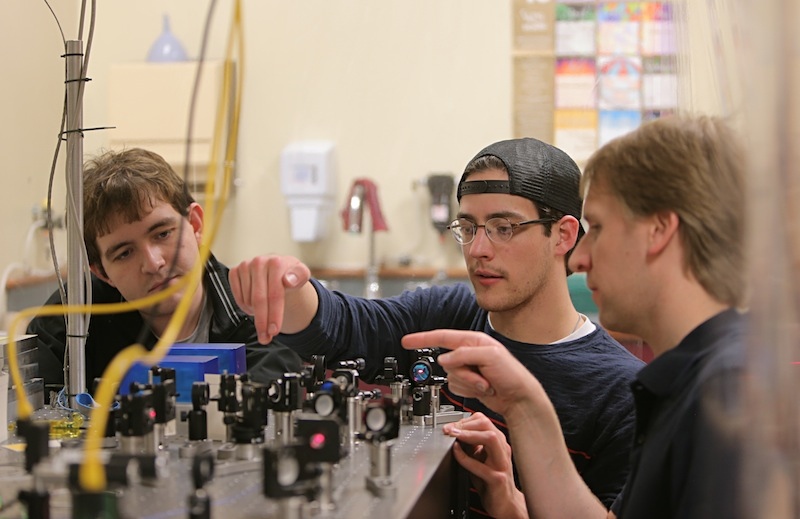Assistant Professor of Physics Steven Olmschenk is conducting cutting-edge research that could potentially predict the future of an unbreakable encryption. Salon recently published an article about his work in the area of quantum information, a variant of quantum physics that allows large numbers to be crunched down into very small spaces – all the way down to the atomic level.
The most exciting result of reducing large quantities of information into extremely small spaces is that enormous numbers of algorithms can be run in very small amounts of time. Olmschenk estimates that the information contained in just 30-40 atoms can be compared to a volume held in a supercomputer. “And reducing large amounts of information into very small spaces would allow you to create almost unbreakable encryptions.”
So, how does all this work?
By way of background, your computer and mobile phone most likely use a binary system to store and work with data. Remembering our middle school math, the binary system uses a series of 1’s and 0’s that are combined to represent any number. In Olmschenk’s work, those 1 and 0 values are assigned to atoms.
But in quantum physics, a single entity can have the property of both a 1 and a 0 (When things get down to a subatomic level, the lines can get pretty fuzzy, like between water and ice.)
To reference another school lesson — this time chemistry — there are three parts of an atom: protons are positively charged, electrons are negatively charged and neutrons have no charge. Olmschenk is able to produce an atom with two properties by assigning values to the electron clouds that surround the neutron and proton.
In order to create this quantum slight-of-hand, Olmschenk manipulates the atoms under extreme conditions. First, he traps the atom in a magnetic field, then he cools it with a laser to minus 460°F – one of the coldest temperatures ever achieved. He cools the atoms to slow them down and fix the information in the electron clouds surrounding proton and/or neutron.
So now, huge amounts of data can be stored in a very small space, but for it to become usable, especially for encryption, the data must be easily transported from one place to another, and preferably with the ability to traverse long distances. This is where Olmschenk’s groundbreaking work becomes unique.
Most research along these lines has used ultraviolet (UV) lasers in the process. UV lasers aren’t compatible with existing systems of transporting data over long distances. Infrared lasers work much better with those system, but it has been difficult to find atoms that work well under infrared conditions. Olmschenk is using a rare atom, lanthanum, for his work, and he’s finding that so far, it is working quite well.
Olmschenk’s work takes place in the lower level of F.W. Olin Science Hall on the Denison campus, where he built the laser and conducts his experiments with students. “The really cool thing is that students can work on this cutting-edge research with me,” he says. “The result of this research will be available to the public when it is published.” Olmschenk humorously notes that the research that he and his students are conducting will not be encrypted.
Last fall, Olmschenk received a grant to research “Laser cooling trapped ions with telecom light for applications in quantum information.” The grant is funded by the Department of the Army for $137,763 over three years. It provides partial support for equipment, supplies, and two Denison summer research students. Olmschenk also has received an additional $35,000 grant from Research Corporation. The award is a single investigator Cottrell College Science Award, and his project is titled “Laser Cooling and Trapping of Atomic Ions with Telecom Light.” The funds will support equipment for the experiments, as well as support additional student research on the project.






